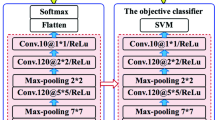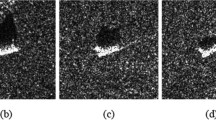Abstract
Synthetic aperture radar (SAR) automatic target recognition (ATR) technology is one of the research hotspots in the field of image cognitive learning. Inspired by the human cognitive process, experts have designed convolutional neural network (CNN)-based SAR ATR methods. However, the performance of CNN significantly deteriorates when the labeled samples are insufficient. To effectively utilize the unlabeled samples, we present a novel semi-supervised CNN method. In the training process of our method, the information contained in the unlabeled samples is integrated into the loss function of CNN. Specifically, we first utilize CNN to obtain the class probabilities of the unlabeled samples. Thresholding processing is performed to optimize the class probabilities so that the reliability of the unlabeled samples is improved. Afterward, the optimized class probabilities are used to calculate the scatter matrices of the linear discriminant analysis (LDA) method. Finally, the loss function of CNN is modified by the scatter matrices. We choose ten types of targets from the Moving and Stationary Target Acquisition and Recognition (MSTAR) dataset. The experimental results show that the recognition accuracy of our method is significantly higher than other semi-supervised methods. It has been proved that our method can effectively improve the SAR ATR accuracy when labeled samples are insufficient.






Similar content being viewed by others
References
Gao F,Yang Y, Wang J, Sun J, Yang E, Zhou H. A Deep Convolutional Generative Adversarial Networks (DCGANs)-Based Semi-Supervised Method for Object Recognition in Synthetic Aperture Radar (SAR) Images. Remote Sens. 2018;10(6):846.
Wang G, Tan S, Guan C, Wang N, Liu Z. Multiple model particle filter track-before-detect for range ambiguous radar. Chin J Aeronaut. 2013;26:1477–87.
Ma F, Gao F, Sun J, Zhou H, Hussain A. Weakly Supervised Segmentation of SAR Imagery Using Superpixel and Hierarchically Adversarial CRF. Remote Sens. 2019;11(5):512.
Chen H, Zhang F, Tang B, Yin Q, Sun X. Slim and efficient neural network design for resource-constrained SAR target recognition. Remote Sens. 2018;10(10):1–15.
Zhang F, Yao X, Tang H,Yin Q, Hu Y, Lei B. Multiple Mode SAR Raw Data Simulation and Parallel Acceleration for Gaofen-3 Mission. IEEE J. Sel. Top. Appl. Earth Observ. Remote Sens. 2018:1-12.
Garagnani M, Wennekers T, Pulvermüller F. Recruitment and consolidation of cell assemblies for words by way of hebbian learning and competition in a multi-layer neural network. Cogn Comput. 2009;1(2):160–76.
Zhang S, He B, Rui N, Wang J, Han B, Lendasse A. Fast image recognition based on independent component analysis and extreme learning machine. Cogn Comput. 2014;6(3):405–22.
Gao F, Ma F, Wang J, Sun J, Yang E, Zhou H. Visual saliency modeling for river detection in high-resolution SAR imagery. IEEE Access. 2018; 6:1000-14.
Gao F, Ma F, Zhang Y, Wang J, Sun J, Yang E, et al. Biologically inspired progressive enhancement target detection from heavy cluttered SAR images. Cogn Comput. 2016;8(5):955–66.
Spratling M. A hierarchical predictive coding model of object recognition in natural images. Cogn Comput. 2017;9(2):151–67.
Ren P, Sun W, Luo C, Hussain A. Clustering-oriented multiple convolutional neural networks for single image super-resolution. Cogn Comput. 2018;10(1):165–78.
Chen Y, Jiang H, Li C, Jia X, Ghamisi P. Deep feature extraction and classification of hyperspectral images based on convolutional neural networks. IEEE Trans Geosci Remote Sens. 2016;54(10):6232–51.
Amrani M, Jiang F. Deep feature extraction and combination for synthetic aperture radar target classification. J Appl Remote Sens. 2017;11(4):1.
Zhao J, Guo W, Cui S, Zhang Z, Yu W. Convolutional neural network for SAR image classification at patch level. Geoscience and Remote Sensing Symposium IEEE. 2016:945–8.
Chen S, Wang H. SAR target recognition based on deep learning. International Conference on Data Science and Advanced Analytics IEEE 2015; pp 541–7
Gao F, Huang T, Sun J, Wang J, Hussain A, Yang E. A new algorithm of SAR image target recognition based on improved deep convolutional neural network. Cogn Comput. 2018:1–16.
Liu B, Yu X, Zhang P, Tan X, Yu A, Xue Z. A semi-supervised convolutional neural network for hyperspectral image classification. Remote Sens Lett. 2017;8(9):839–48.
Fu Z, Zhang F, Yin Q, Li R, Hu W, Li W. Small sample learning optimization for ResNet based SAR target recognition. International Geoscience and Remote Sensing Symposium IEEE. 2018:2330–3.
Zhu X, Rogers T, Qian R, Kalish C. Humans perform semi-supervised classification too. National Conference on artificial intelligence AAAI Press 2007;864–9.
Haeusser P, Mordvintsev A, Cremers D. Learning by association—a versatile semi-supervised training method for neural networks. In Proceedings of IEEE conference on computer vision and pattern recognition 2017; pp. 626–35.
Gibson B, Rogers T, Zhu X. Human semi-supervised learning. Top Cogn Sci. 2013;5(1):132–72.
Hänsch R, Hellwich O. Semi-supervised learning for classification of polarimetric SAR-data. Geoscience and Remote Sensing Symposium IEEE. 2010:987–90.
Uhlmann S, Kiranyaz S, Gabbouj M. Semi-supervised learning for ill-posed polarimetric SAR classification. Remote Sens. 2014;6(6):4801–30.
Basu S. Semi-supervised learning. Pacific-Asia conference on advances in knowledge discovery and data mining 2010;588–95.
Leng Y, Xu X, Qi G. Combining active learning and semi-supervised learning to construct SVM classifier. Knowl-Based Syst. 2013;44:121–31.
Zhang X, Song Q, Liu R, Wang W, Jiao L. Modified co-training with spectral and spatial views for semisupervised hyperspectral image classification. IEEE J Sel Top Appl Earth Observ Remote Sens. 2014;7(6):2044–55.
Lv L, Zhao D, Deng Q. A semi-supervised predictive sparse decomposition based on task-driven dictionary learning. Cogn Comput. 2016;9(1):1–10.
Ding S, Xi X, Liu Z, Qiao H, Zhang B. A novel manifold regularized online semi-supervised learning model. Cogn Comput. 2018;10(1):49–61.
Rasmus A, Valpola H, Honkala M, Berglund M, Raiko T. Semi-supervised learning with ladder networks. Comput Sci. 2015;9(Suppl 1):1–9.
Laine S, Aila T. Temporal ensembling for semi-supervised learning. International conference on learning representations 2017.
Le T, Kim S. A hybrid selection method of helpful unlabeled data applicable for semi-supervised learning algorithms. The IEEE International Symposium on Consumer Electronics. 2014:1–2.
Li Y, Zhou Z. Towards making unlabeled data never hurt. IEEE Trans Pattern Anal Mach Intell. 2015;37(1):175–88.
Huang Y, Wang S, Ren S. Pinning exponential synchronization and passivity of coupled delayed reaction-diffusion neural networks with and without parametric uncertainties. Int. J. Control. 2017:1-35.
Huang Y, Qiu S, Ren S. Finite-time synchronization and passivity of coupled memristive neural networks. Int. J. Control. 2019.
Moskowitz L. The LDA—an integrated diagnostics tool. IEEE Aerosp Electron Syst Mag. 1986;1(7):22–6.
Huan R, Liang R, Pan Y. SAR target recognition with the fusion of LDA and ICA. International Conference on Information Engineering and Computer Science IEEE. 2009:1–5.
Funding
This research was funded by the National Natural Science Foundation of China (No. 61771027, No. 61071139, No. 61471019, No. 61501011, and No. 61171122). E. Yang is supported in part under the RSE-NNSFC Joint Project (2017–2019) (No. 6161101383) with China University of Petroleum (Huadong). H. Zhou was supported by UK EPSRC under Grant EP/N011074/1, Royal Society-Newton Advanced Fellowship under Grant NA160342, and European Union’s Horizon 2020 research and innovation program under the Marie-Sklodowska-Curie grant agreement No 720325.
Author information
Authors and Affiliations
Corresponding author
Ethics declarations
Conflict of Interest
The authors declare that they have no conflict of interest.
Ethical Approval
This article does not contain any studies with human participants performed by any of the authors.
Additional information
Publisher’s Note
Springer Nature remains neutral with regard to jurisdictional claims in published maps and institutional affiliations.
Rights and permissions
About this article
Cite this article
Yue, Z., Gao, F., Xiong, Q. et al. A Novel Semi-Supervised Convolutional Neural Network Method for Synthetic Aperture Radar Image Recognition. Cogn Comput 13, 795–806 (2021). https://doi.org/10.1007/s12559-019-09639-x
Received:
Accepted:
Published:
Issue Date:
DOI: https://doi.org/10.1007/s12559-019-09639-x




